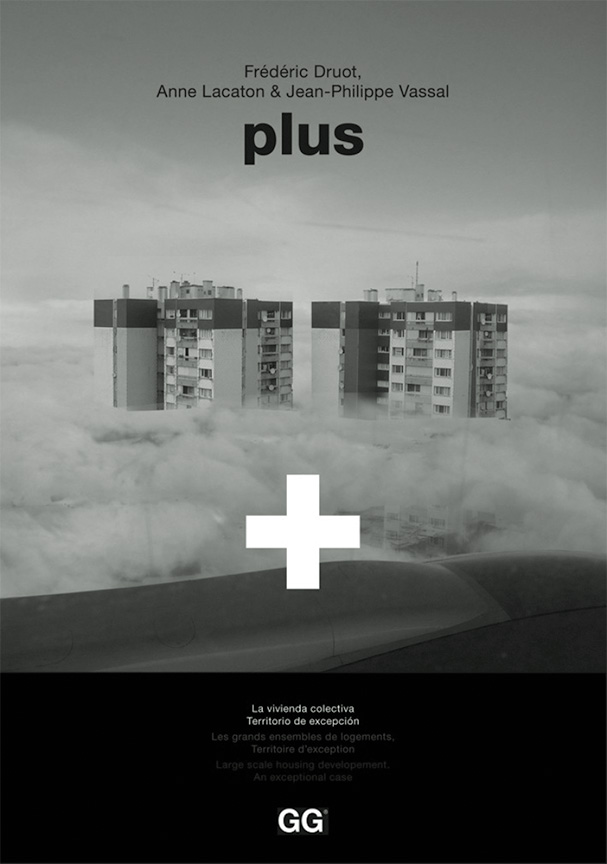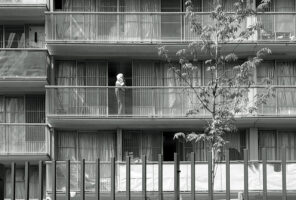Plus
Book review Frédéric Druot, Anne Lacaton, Jean-Philippe Vasal: Plus, Editorial Gustavo Gili, Barcelona, 2007, published in: De Architect, 2008
 The French duo of architects Anne Lacaton and Jean-Philippe Vasal, with Frédéric Druot, have made a book about the redevelopment of postwar residential buildings. The book titled Plus opens with pungent statements. For example, according to the authors, post-war buildings should never be demolished, degraded or replaced, but rather used and upgraded through a strategy of addition and continuous transformation. Furthermore, the suburban residential building should offer maximum comfort and luxury. The idiosyncratic tone of Plus is thus set.
The French duo of architects Anne Lacaton and Jean-Philippe Vasal, with Frédéric Druot, have made a book about the redevelopment of postwar residential buildings. The book titled Plus opens with pungent statements. For example, according to the authors, post-war buildings should never be demolished, degraded or replaced, but rather used and upgraded through a strategy of addition and continuous transformation. Furthermore, the suburban residential building should offer maximum comfort and luxury. The idiosyncratic tone of Plus is thus set.
Lacaton and Vasal are known for their realism and fascination with construction costs. In their private homes, they mix solid construction with cheaper makeshift structures. Greenhouse constructions, for example, efficiently make it possible to enlarge residential volumes. Crucially, of course, the architects provide customized solutions. Their solutions coincide with the unique desires of owner-occupants. They provide substance to modernist themes dusted off by Rem Koolhaas such as cheapness, no-money-no-detail and the Spartan-hedonistic lifestyle.

This approach has been transferred to the post-war housing stock. The assumption in the design exercises in Plus is the low residual value of the property. Existing shells are enlarged (as are private residences) with lightweight structures creating surplus living space, terraces and collective spaces. The site drawings suggest that the open subdivision of post-war French residential neighbourhoods has sufficient absorptive capacity for the expansion of the encroachments for now. Yet, not urbanism, but dwelling is the central topic. Interior images are mounted first in a shell of a concrete system building and then in a glassy renewal of it. These not-like-this-but-like that series are somewhat didactic but undeniably challenging, showing how the designers’ handwriting dissolves clash-free into postwar modernism.
Plus conveys a cheap and cheerful message. Consequently, in addition to the architectural image, the designers address construction costs. The underpinning of this and especially of the process costs is lacking, but more relevant is the question of why the designers focus one-sidedly on the investments without weighing the financial returns. After all, future opportunities are at stake in this type of intervention. These relate directly to possible operating periods and returns and thus influence the investment space. There is a relationship between architectural intervention and earning capacity. The real estate world also knows the difference between ´expensive´ and ´a lot of money’. It is entirely possible that prudent investments with a short duration will yield worse returns than costly interventions with an assured long operating period without high maintenance costs.

Another question is how these designs function in an anonymous housing market. The Spartan-hedonistic images will appeal to readers of architecture magazines, but it is an obstinate cliché that dwellings in the French banlieu are inhabited by a bourgeois middle class with dreams all of their own and by child-rich immigrant families, who need lots of rooms with hallways rather than classy lofts. This programmatic point also touches on the future prospects of the postwar residential building.
Tracts are there to excite, persuade and provoke dissent. Plus gives every reason to do so. It is trilingual and full of observations and lines of thought. One merit of this tract is that leading architects engage with the problem of postwar housing and put it on the agenda as an international architectural task.